WABCO 常规制动系统培训教程201011
- 格式:pdf
- 大小:1.54 MB
- 文档页数:30
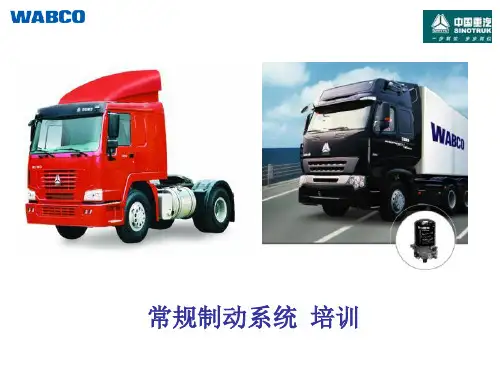
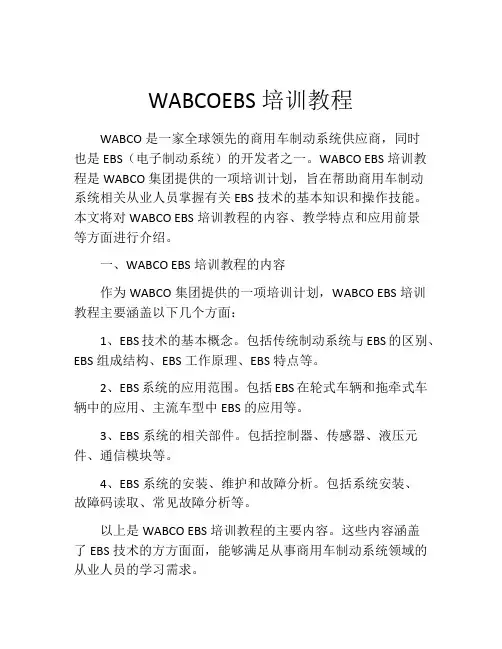
WABCOEBS培训教程WABCO是一家全球领先的商用车制动系统供应商,同时也是EBS(电子制动系统)的开发者之一。
WABCO EBS培训教程是WABCO集团提供的一项培训计划,旨在帮助商用车制动系统相关从业人员掌握有关EBS技术的基本知识和操作技能。
本文将对WABCO EBS培训教程的内容、教学特点和应用前景等方面进行介绍。
一、WABCO EBS培训教程的内容作为WABCO集团提供的一项培训计划,WABCO EBS培训教程主要涵盖以下几个方面:1、EBS技术的基本概念。
包括传统制动系统与EBS的区别、EBS组成结构、EBS工作原理、EBS特点等。
2、EBS系统的应用范围。
包括EBS在轮式车辆和拖牵式车辆中的应用、主流车型中EBS的应用等。
3、EBS系统的相关部件。
包括控制器、传感器、液压元件、通信模块等。
4、EBS系统的安装、维护和故障分析。
包括系统安装、故障码读取、常见故障分析等。
以上是WABCO EBS培训教程的主要内容。
这些内容涵盖了EBS技术的方方面面,能够满足从事商用车制动系统领域的从业人员的学习需求。
二、WABCO EBS培训教程的教学特点WABCO EBS培训教程在教学上具有以下几个特点:1、模块化教学。
WABCO EBS培训教程将EBS技术的各个方面划分成不同的模块,使学员能够根据自己的需求选择相应的模块进行学习。
2、实践性强。
WABCO EBS培训教程在教学设计上,将理论教学和实践操作相结合,使学员能够深入了解EBS系统的工作原理,并掌握操作技能。
3、教学系统化。
WABCO EBS培训教程采用完整的教学系统,包括教学大纲、教学课件、实验器材等,确保学员能够在一个系统化的教学环境下进行学习。
4、教学针对性强。
WABCO EBS培训教程将教学对象定位在商用车制动系统从业人员上,因此,它的教学内容和方法都是针对性很强的,能够让学员快速地掌握EBS技术。
以上是WABCO EBS培训教程的教学特点。
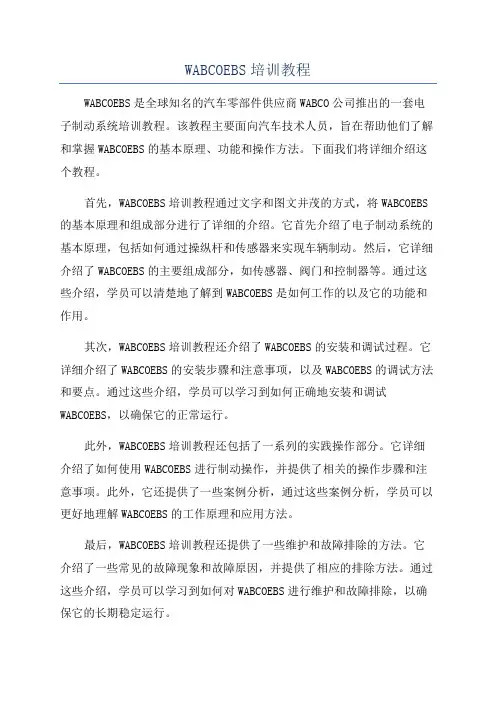
WABCOEBS培训教程WABCOEBS是全球知名的汽车零部件供应商WABCO公司推出的一套电子制动系统培训教程。
该教程主要面向汽车技术人员,旨在帮助他们了解和掌握WABCOEBS的基本原理、功能和操作方法。
下面我们将详细介绍这个教程。
首先,WABCOEBS培训教程通过文字和图文并茂的方式,将WABCOEBS 的基本原理和组成部分进行了详细的介绍。
它首先介绍了电子制动系统的基本原理,包括如何通过操纵杆和传感器来实现车辆制动。
然后,它详细介绍了WABCOEBS的主要组成部分,如传感器、阀门和控制器等。
通过这些介绍,学员可以清楚地了解到WABCOEBS是如何工作的以及它的功能和作用。
其次,WABCOEBS培训教程还介绍了WABCOEBS的安装和调试过程。
它详细介绍了WABCOEBS的安装步骤和注意事项,以及WABCOEBS的调试方法和要点。
通过这些介绍,学员可以学习到如何正确地安装和调试WABCOEBS,以确保它的正常运行。
此外,WABCOEBS培训教程还包括了一系列的实践操作部分。
它详细介绍了如何使用WABCOEBS进行制动操作,并提供了相关的操作步骤和注意事项。
此外,它还提供了一些案例分析,通过这些案例分析,学员可以更好地理解WABCOEBS的工作原理和应用方法。
最后,WABCOEBS培训教程还提供了一些维护和故障排除的方法。
它介绍了一些常见的故障现象和故障原因,并提供了相应的排除方法。
通过这些介绍,学员可以学习到如何对WABCOEBS进行维护和故障排除,以确保它的长期稳定运行。
总的来说,WABCOEBS培训教程通过详细介绍WABCOEBS的基本原理、功能和操作方法,帮助学员全面了解和掌握WABCOEBS的使用方法。
它不仅提供了理论知识,还提供了实践操作和故障排除的方法,以帮助学员提高实际操作和问题解决的能力。
通过学习WABCOEBS培训教程,汽车技术人员可以更好地理解和使用WABCOEBS,并提高自己的技术水平。

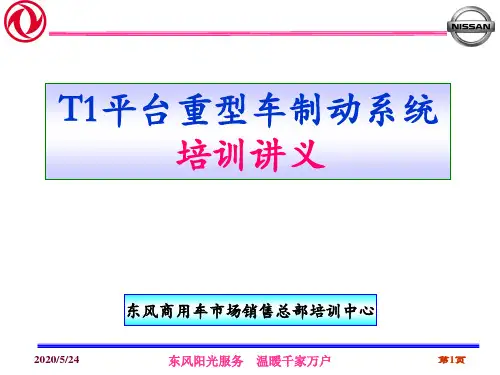
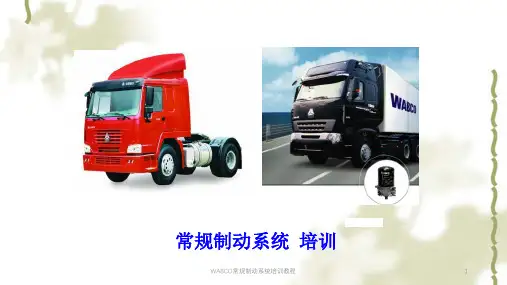
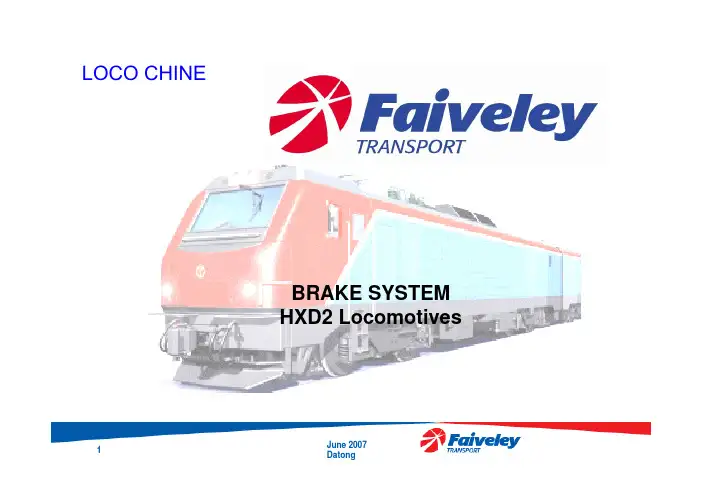
LOCO CHINEBRAKE SYSTEMHXD2 LocomotivesJune 2007General data of the locomotiveNormal service : 2 locomotives coupled togetherLocomotive 1 : master(generator of BP pressure active)Locomotive 2 : slave(generator of BP pressure no active)June 2007Type of brakes•Pneumatic friction brake•Electro-dynamic brake•Automatic parkingbrakeThe pneumatic friction brake is controlled by the driver’s brake valve (Eurotrol).June 2007Brake systemsDual brake pipe modes•Passengers (brake pipe 6 bar)•Freight (brake pipe 5 bar )Dual brake modes•Gradual control•Direct mode releaseJune 2007Brake commandsJune 2007LOCOTROL System•Multiple unit control system, installed on all units (leading & remote)•All traction and braking commands on the leading locomotive are transmitted to the others through the LOCOTROL systemJune 2007June 2007•Generic hardware & software platform called Gemini II •Controls the pneumatic equipment of the Eurotrol •Interfaced through :– A FIP bus to the train computer– A RS422 link to the LOCOTROL•Based on :–Time dependent inputs from the indirect brake manipulator –Brake demand from LOCOTROL systemBCUBCUJune 2007Brake system •dcwvJune 2007Brake system •Block schemeJune 2007June 2007•Receives its input from the BCU •Modulates the BP pressure–Calculates the internal pressure valve RE–Activates the control valves in a closed loop to obtain the desired pilotpressure REEUROTROLEUROTROL •First brake step pressureJune 2007EUROTROL •Brake applicationJune 2007EUROTROL •Brake releaseJune 2007EUROTROL •Stabilisation after braking or releasingJune 2007EUROTROL •Quick releaseJune 2007EUROTROL •Emergency brakeJune 2007EUROTROL •NeutralisationJune 2007June 2007•One distributor valve group per locomotive •This module :–Realises the automatic pneumatic brake,–Distributes air in the RADistributor valve group•Distributor SW4 G/P mode •Operation mode lever (management of BP reference pressure) :–M (freight) position : P BP = 500kPa–V (passenger) position : P BP = 600kPa•2 release modes : gradual & direct release ( RB(IS)RC cock position )June 2007•Cock RB(IS)RC open (switch closed)•Carried out in large flow (manipulator in GD position)•Only if P BP > 300kPa •If VV(RT)RC detectsa ΔP > 20kPabetween BP & R(T)↘RC discharge itselfinside BP↘The distributor is able to release the brake more quickly Direct release modeBrake releaseDirect release mode Brake releaseJune 2007Direct release mode Brake applicationJune 2007•Cock RB(IS)RC closed (switch open)Gradual release mode Brake applicationJune 2007LOCO CHINE DJ4Gradual release modeBrake releaseJune 2007HXD2 LocomotiveBrake releaseFor dynamic brake applicationJune 2007DIRECT BRAKEmanipulator•Controlled by the BCU onrequest of the LOCOTROLsystem, on the remotelocomotiveJune 2007DIRECT BRAKE •Brake applicationJune 2007DIRECT BRAKE •Release positionJune 2007DIRECT BRAKE •Brake cylinder pressure maintainingJune 2007HXD2 LocomotiveEMERGENCY BRAKE•Venting of the RE pilot pressure& of the brake pipeJune 2007EMERGENCY BRAKE•Action on the cabin’s emergencyequipment (push buttons)•Fast venting of the BPthrough a big hole(ø= 25mm)June 2007EMERGENCY BRAKE•Emergency brakingdone by the safety equipmentJune 2007PARKING BRAKE •Spring applied /pressure released type •Under the RA controlJune 2007PARKING BRAKE •The parking brake ventingJune 2007PARKING BRAKE •The parking brake ventingJune 2007PARKING BRAKE •The parking brake isolatingJune 2007Isolation •Parking brake isolationJune 2007•Parking brake isolationJune 2007Isolation •Direct brake isolationJune 2007•Direct brake isolationJune 2007•Brake cylinder isolationJune 2007•Brake cylinder isolationJune 2007Isolation •EUROTROL / CG isolating module (master / slave)June 2007•Eurotrol isolationJune 2007Isolation •Distributor / MP isolationJune 2007Isolation •Distributor / BP isolationJune 2007•MP/CG isolationJune 2007BRAKE PANEL •June 2007BRAKE PANEL •June 2007BRAKE PANEL (prototype)•June 2007。
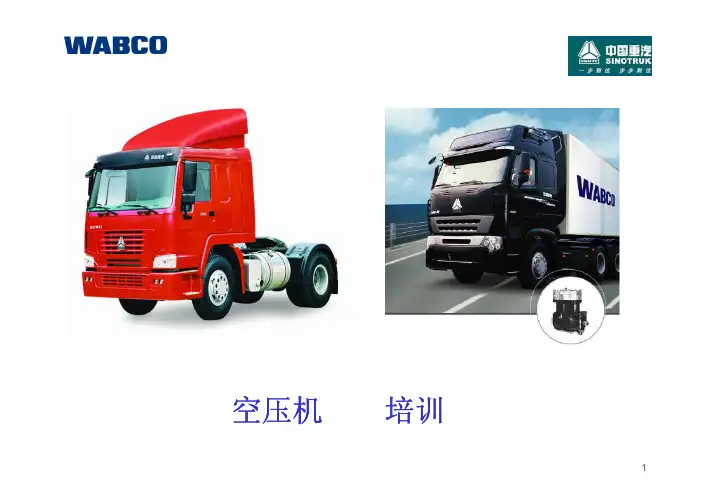
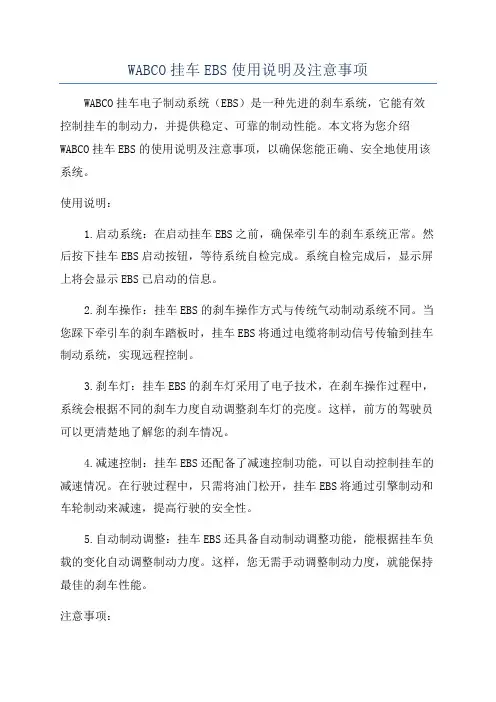
WABCO挂车EBS使用说明及注意事项WABCO挂车电子制动系统(EBS)是一种先进的刹车系统,它能有效控制挂车的制动力,并提供稳定、可靠的制动性能。
本文将为您介绍WABCO挂车EBS的使用说明及注意事项,以确保您能正确、安全地使用该系统。
使用说明:1.启动系统:在启动挂车EBS之前,确保牵引车的刹车系统正常。
然后按下挂车EBS启动按钮,等待系统自检完成。
系统自检完成后,显示屏上将会显示EBS已启动的信息。
2.刹车操作:挂车EBS的刹车操作方式与传统气动制动系统不同。
当您踩下牵引车的刹车踏板时,挂车EBS将通过电缆将制动信号传输到挂车制动系统,实现远程控制。
3.刹车灯:挂车EBS的刹车灯采用了电子技术,在刹车操作过程中,系统会根据不同的刹车力度自动调整刹车灯的亮度。
这样,前方的驾驶员可以更清楚地了解您的刹车情况。
4.减速控制:挂车EBS还配备了减速控制功能,可以自动控制挂车的减速情况。
在行驶过程中,只需将油门松开,挂车EBS将通过引擎制动和车轮制动来减速,提高行驶的安全性。
5.自动制动调整:挂车EBS还具备自动制动调整功能,能根据挂车负载的变化自动调整制动力度。
这样,您无需手动调整制动力度,就能保持最佳的刹车性能。
注意事项:1.定期检查:为确保挂车EBS的正常运行,建议定期检查系统的电缆连接是否松动、磨损,以及传感器的工作状态。
如有必要,及时更换损坏的零部件。
2.防止水溅入:挂车EBS的传感器和连接器非常敏感,需要防止水溅入。
在洗车或行驶在湿润环境中后,应及时清洗和干燥传感器和连接器。
3.调整制动力度:挂车EBS具有自动制动调整功能,但有时可能需要手动调整制动力度。
如果发现制动力度过弱或过强,应先检查是否有传感器故障或电缆连接问题,然后再进行调整。
4.保持稳定:在行驶或制动过程中,应尽量保持稳定的行驶状态。
突然变换速度或频繁进行急刹车会对挂车EBS造成额外的压力,影响其性能和寿命。
5.注意维护:挂车EBS系统需要定期维护,包括清洁各个传感器和连接器、更换磨损的零部件等。
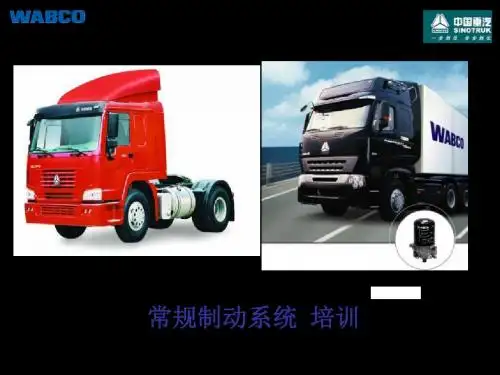
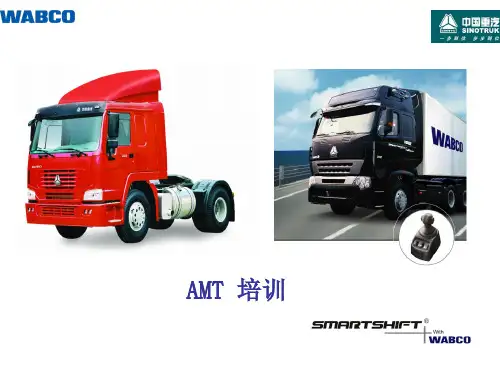
TRAINING培训ABS/ASREBL/TPMCNHTC ABS CNHTC ABS培训教程培训教程气制动系统或空气干燥器空压机前轮盘式制动器悬架控制温度控制缓速器控制贮气筒后轮盘式制动器盘式制动器ABS, EBS电子控制空气悬挂挂车电子中央控制车辆中央控制变速箱控制ABS / ASR/ APU EBS 带稳定性控制离合器控制压力监测(IVTM)或气制动系统和高度传感器ECU全球主要主机客户6060年代中期年代中期年代中期::研制参数模型并将成果应用于飞机19721972 年年:研制出了第一代模拟技术系统19751975 年年:展出展出ABS ABS ABS系统及微处理器技术系统及微处理器技术19811981 年年:展出批量生产的展出批量生产的A A 型ABS(ABS(第一代第一代第一代))19821982 年年:开始大批量生产开始大批量生产A A 型ABS 19851985 年年:开始批量生产开始批量生产B B 型ABS(ABS(第二代第二代第二代))19861986 年年:开始批量生产开始批量生产66通道带通道带ASR ASR ASR功能的功能的功能的ABS ABS 19891989 年年:开始生产挂车开始生产挂车C C 型ABS ABS Vario Vario Vario--C 19901990 年年:开始生产开始生产C C 型ABS (ABS (第三代第三代第三代))19961996 年年:开始批量生产开始批量生产D D -Full Full和和D -Basic Basic型型ABS(ABS(第四代第四代第四代))2000 2000 年年:开始批量生产开始批量生产E E 型ABS (ABS (第五代第五代第五代))WABCO -ABS 发展历史ABS ABS--D D 到到ABS ABS--EABS ABS 的的概念ABS –A nti nti--lock B raking S ystem是在制动期间控制和监视车辆速度的电子系统是在制动期间控制和监视车辆速度的电子系统。
GROUPE DE FONCTIONS 5功能组5FREINS制动Historique历史Le système de freinage qui était, à l'origine, un système entièrement mécanique, estdésormais basé sur une interaction élaborée entre composants électroniques, pneumatiques et mécaniques. Quatre éléments permettent le ralentissement, l'arrêt ou le stationnement d'un véhicule:制动系统初始时期,是完全机械式的。
后来,结合了电子元件、气动及机械形式。
四个部分实现车辆减速、停车或驻车。
∙Frein à pied∙脚制动∙Frein de stationnement∙驻车制动∙Frein moteur∙发动机制动∙Ralentisseur∙缓速器Freins à commande intégralement mécanique机械控制制动À l'origine, le système de freinage d'un camion était intégralement mécanique. La force était transférée de la pédale de frein aux segments de frein à l'aide de câbles et de leviers. Dans la plupart des cas, seules les roues motrices étaient équipées de freins. Par la suite, des freinsfurent installés pour les quatre roues.起初,卡车的制动系统全部是机械式的。